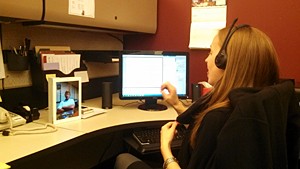
UC Research Examines How Technology Can Break Down Barriers for Deaf and Hard-of-Hearing Students
A small, pilot study is examining how mobile technology might support deaf and hard-of-hearing college students when an interpreter cant physically be present at the time the services are requested. The University of Cincinnati research will be presented on
June 19, at the Critical Link 7 International Conference in Toronto.
The conference is themed, Global Awakening: Leading Practices in Interpreting.
The first phase of the UC research project involved a college student taking a course in a large, auditorium-style classroom. The student used an iPad to gain the services of an interpreter also using an iPad who was off site (but nearby initially, in case of any disruption). In the second half of the pilot study, the technology was tested as the student took part in a cooperative education experience off campus and out of state.
The interpreter was able to listen through the iPad in order to interpret the conversations heard from where the student was located. The student used the iPad to receive the lectures, conversations, meetings, etc., from the signed language interpreter.
Katherine Vance, the interpreter coordinator with UCs Disability Services Office, says she provided the remote interpreting services using Apples FaceTime video calling technology. This could also be considered for possible use by colleges in remote areas that lack a network of interpreters to hire from, adds Vance.
Were examining how technology can be used when an interpreter is available, but physically cant be where the student needs them and at the moment they need them, explains Suzanne Ehrlich, the studys principal investigator and assistant professor and director of the UC Signed Language Interpreting Program.
Findings for the Toronto presentation, Innovative Interpreting: iPad Technology as a Bridge to Services, will be reported by Ehrlich and Vance. Greg Crase, IT coordinator for Disability Services, also was a researcher on the project.
The students co-op employer gave the test project a positive review, say the researchers. The employer reported that while using the iPad to communicate with colleagues, the student was perceived to have been more engaged in meetings where the iPad was used for interpreting services.
Challenges, say the researchers, included running into connectivity issues that can result with inconsistencies in using Wi-Fi technology. However, the researchers also emphasize that those challenges did not detract from the students co-op experience.
The researchers say they plan to expand the project beyond the first phase of the pilot study to test the technology on additional students, as well as examine which technology is best, user perception and frequency/type of use for on-demand services.
Other services such as Communication Access Real-Time Translation (CART), C-Print, note-taking and text messaging have opened information to sign language users, in addition to the more recent, fee-for-service Video Remote Interpreting (VRI) and Video Relay Services (VRS) which uses video conferencing equipment.
Ehrlich says the increasing need for interpreters and professionalism in the field has resulted in the development of a bachelors degree at UC in signed language interpreting, including a distance learning program.
She says that more than 1,000 students are involved in taking American Sign Language (ASL) classes at UC.
Related Stories
University of Cincinnati students taking class to see realities...
November 25, 2024
WLWT reporter Lindsay Stone visited the University of Cincinnati campus and the River City Correctional Center to get a better understanding of the "Inside-Outside" program, led by UC’s J.Z. Bennett.
Black Thriving in America: A Continued Conversation Dec. 2
Event: December 2, 2024 4:00 PM
The School of Criminal Justice – part of the College of Education, Criminal Justice, Human Services, and Information Technology – invites the UC community and public to “Black Thriving in America: A Continued Conversation” on Dec. 2. The event explores critical insights from the 2024 report on Black life experiences in America.
This UC student sees success in the checkpoints
November 21, 2024
Siinboon Daba, a fourth-year cybersecurity major in the University of Cincinnati's College of Education, Criminal Justice, Human Services, and Information Technology, found the secret to effective time management and a full life at UC.
